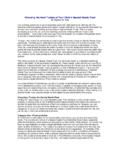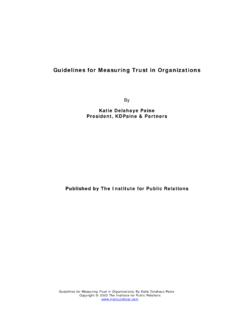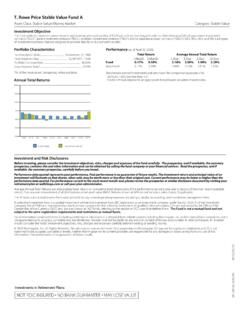Transcription of 30 Reit or business trust? - MoneySense
1 REITS (real estate investment trusts) andbusiness trusts may seem to be attractiveoptions, particularly as upwardly trendinginflation puts savers in an awkward andworrisome quandary of negative real inter-est attractiveness of such trusts lie intheir ability to pay a regular and stable divi-dend. This is a big plus in a portfolio. Re-search into long-term returns shows thatreinvested dividends comprise the bulk ofreturns, compared to capital before you take the plunge, youshould, as always, examine the listedtrusts in the context of your entire portfo-lio. If you are underinvested in equities,an allocation into such income-bearing in-struments may be a prudent way to stepup your risk exposure, and yet enhanceyour portfolio yield. If you are already ade-quately or even overexposed to equities,you may want to consider trimming someof your risk assets in favour of a more sta-ble dividend-yielding Reits and business trusts offer expo-sure to a broad range of industries andtypes of assets, you should do your home-work on the ones you may be keen are some key points to consider:45 Your risk tolerance and investment ho-rizon:Reits and business trusts are similarto bonds in that they generate an incomestream, but they will be more volatile thanbonds, and more highly correlated withstocks.
2 You will also need to be preparedto hold them for a longer period to benefitfrom dividend the underlying assets:EachReit or business trust will offer exposure toa specific sector. Peruse the trust s websitefor relevant documents their trackrecord of dividends; statements on theiroperating environment; gearing levels anddebt maturity concentrated are the trust s assets?The assets, for instance, may depend heav-ily on tenants from a specific sector,which would make the trust vulnerable toa downturn in that sector. It would be pru-dent if the trust s assets are sufficiently di-versified in terms of tenant mix, geogra-phy and industry it is a foreign Reit or business trust ,you will need to be aware of the operatingenvironment as well in the country, includ-ing regulatory or political risks. The macr-oeconomic environment will also impacttheir businesses.
3 Ascertain, too, the trust sgrowth potential: is it able to makeyield-accretive investments?45Be aware of factors relating to thetrust s structure:One is the sponsor, if thetrust has one. What is the sponsor s finan-cial strength? Has the sponsor supportedthe trust on previous occasions when thetrust needed help in financing, for in-stance? This may give an indication of thesponsor s willingness and ability to helpshould there be another financial crisis. Inthe recent crisis, a number of Reits resort-ed to raising capital through a rights may pose a financial strain on your management of the trust is yet an-other important aspect. Ascertain the qual-ity of management and its track is management remunerated? Sometrusts provide for remuneration by unitsto align the manager s interests withunitholders .45 Fees:Reits and business trusts levy anumber of fees, including an annual man-agement fee; performance fee; propertymanagement, acquisition and divestmentfees.
4 Might the fees incentivise managersto take on more debt? On performancefees, in particular, there is no uniform for-mula for the calculation, and the bench-mark used to measure outperformancemay also not be transparent. The prospec-tus will typically have an illustration ofhow the performance fee is payments:How frequentlyare dividends paid? There may be circum-stances when dividends may be cut or sus-pended, such as when the trust isloss-making or when rental income Genevieve CuaWITH interest ratesstill scraping rockbottom, you are like-ly to be on the look-out for investmentsthat offer yield. Within this segment, realestate investment trusts (Reits) and busi-ness trusts are promising investment give you access to yield-bearingassets such as properties or infrastructurethat as a retail investor, you are unlikely tobe able to invest in directly.
5 Most of atrust s underlying assets require substan-tial amounts of capital to acquire as wellas expertise to now, Reits are a fairly mature mar-ket here, boasting a market capitalisationof roughly US$30 billion as at end-Decem-ber. There are also a number of businesstrusts to consider, offering exposure to as-sets such as utilities, shipping and concept of Reits and businesstrusts may seem broadly similar. An out-standing feature of such trusts is their abili-ty to earn or generate a stable income orcash flow, which is distributed regularly tounitholders in the form of , there are key differences in their re-spective structures, with implications forownership, management and Reit is a collective investmentscheme investing in real estate, whichcould span commercial, industrial, retailor hospitality. It is managed by a licensedmanager who is paid an annual manage-ment underlying assets of a Reit are heldby a trustee on unitholders behalf.
6 WithReits, there is a separation of roles be-tween the trustee and the contrast, a business trust is a hybridstructure combining elements of a compa-ny and a trust . It runs a business enter-prise, investing in sectors and assets witha stable income profile such as utilitiesand infrastructure. But unlike a company,it is not a separate legal , it is created by a trust deed un-der which the trustee has legal ownershipof the trust assets, and manages the assetsfor unitholders benefit. It is managed by asingle entity the accompanying graphic illustratessome key aspects of three structures companies, business trusts and are some issues relating to corpo-rate governance that are worth of manager or trustee-mana-ger:The trustee-manager of a businesstrust can be removed only if 75 per cent ofunitholders vote against him. A Reit re-quires a simple majority of votes to re-move a of directors:There arealso rules in place to guard against conflictof interest.
7 For business trusts, the majori-ty of its board must be independent ofmanagement and business relationshipswith the trustee-manager. In addition, atleast one-third must be independent ofmanagement and business relationshipswith the trustee-manager, and from everysubstantial shareholder of the Partnership deputy head (equitycapital markets) Long Chee Shan says thatthe composition of the board of directorsof a business trust is subject to stricterrules relating to the independence of its di-rectors. For business trusts, the law requires themajority of its board members to be inde-pendent. This is unlike managers of Reits,or the boards of listed companies, wherethe Code of Corporate Governance re-quires that only one-third of the directorsbe independent. He also notes the higher threshold for re-moval of a trustee-manager compared tothat for a Reit manager.
8 Unlike a Reitwhich is a passive investment holding ve-hicle that is externally managed, the trus-tee-manager of a business trust managesits business and operations. If the thresh-old is set too low, it may be difficult for thetrustee-manager to plan and manage thebusiness of the trust in the interests ofunitholders. 45 Audit committees:Reits and businesstrusts are required to have an audit com-mittee, which oversees financial reportingand both structures, sale and purchasetransactions with interested parties aresubject to safeguards:Any transaction rep-resenting 5 per cent or more of an entity snet asset value must be approved by inde-pendent are also required under the Codeof Collective Investment Schemes to gettwo independent valuations. Assets can-not be acquired from the interested partyat a price above the higher of the two valu-ations, nor be sold at a price below thelower of the two are, of course, risks attached to in-vestments in Reits and business trusts, aswith any other investment.
9 Here are someto consider:45 Market risk:As listed vehicles, Reitsand business trusts are subject to factorsthat may now and again cause the stockmarket to rise or fall. These include fundflows, investor sentiment and risk appe-tite. While the trusts are generally stablevehicles, there is volatility in their risk:The 2008 crisis eloquent-ly showed that even stable vehicles suchas Reits could suddenly become illiquidalong with the general market. Comparedto unit trusts, Reits and business trusts aresubject to greater liquidity risk. Unit trustinvestors can buy and sell units throughbanks, and fund managers are bound toredeem units except in certain extremeconditions. For Reits and business trusts,the ease of buying and selling units will de-pend on the demand/supply situation onthe : business trusts and Reitsare allowed to take on borrowings to buyassets.
10 Reits are subject to a gearing limitof 35 per cent. This can be raised to 60 percent if the Reit obtains, discloses andmaintains a credit rating from rating agen-cies. There is no explicit cap on borrow-ings for business trusts but the trusts them-selves may set their own Partnership s Mr Long says thatthe absence of a similar cap on gearing forbusiness trusts is not necessarily a nega-tive. The absence of similar restrictions.. allows ( business trusts) more flexibilityin the borrowing of funds to grow its busi-ness in a low interest rate environment. Insuch an environment, a business trustmay take advantage of opportunities topurchase higher yielding assets by gearingup more readily. The presence of leverage gives rise to re-lated risks that of refinancing the borrow-ings as they come due, in addition to thespectre of breaching loan covenants dueto negative equity.




